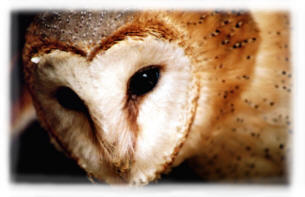There are 35 subspecies of barn owl, the scientific name for the the British form is Tyto alba alba. It's nearest relative is a buff breasted form found in the colder climates of north and east Europe (Tyto alba guttata). The barn owl often appears almost totally white especially when flying hence another popular name of 'White Owl'. Its white, heart-shaped face, makes the barn owl distinctive and unlike many other species of owl it does not have 'ear' tufts. The male generally appears lighter in colour on the back and has a broad white collar, extending from the breast almost to the nape of the neck. The female often has more obvious black spotting on the flanks and underwings. The images on this page show just how extreme the differences in appearance of the sexes can be.
The familiar "Twit" or "Twoo" does not belong to the barn owl, instead they have a range of screeches and snoring sounds that are quite unique and once heard they are never forgotten. However like other owls the barn owl clicks it's beak when it is agitated or if it feels threatened. Young barn owls also make the snoring noises when they are demanding to be fed. Barn owls normally pair for life occupying a territory of one to two square miles. It is a sedentary bird usually remaining faithful to its chosen nest site throughout its life. Nest sites have been known to be used by successive generations of owls for decades, even centuries. This continued use of nest sites by succesive generations can sometimes make it difficult to measure the life span of barn owls which in the wild may average out to be as little as three years. |

 Barn owls are normally nocturnal but
this is not always the case; some are completely
nocturnal whilst others commonly hunt well before it gets
dark. Hunting during daylight often occurs when there are
owlets to feed or when food is short, such as during
harsh winters and summer droughts. Barn owls usually
arrive at their day-time roost before dawn and remain
there until hunting and feeding resumes. Most hunting is
done during the evening and before midnight, but often
there is another period of activity in the hour or two
before sunrise. The owls soon become familiar with their
territories usually flying directly to a favoured hunting
area of rough grassland where voles, shrews, mice and
other small mammals may be found.
Barn owls are normally nocturnal but
this is not always the case; some are completely
nocturnal whilst others commonly hunt well before it gets
dark. Hunting during daylight often occurs when there are
owlets to feed or when food is short, such as during
harsh winters and summer droughts. Barn owls usually
arrive at their day-time roost before dawn and remain
there until hunting and feeding resumes. Most hunting is
done during the evening and before midnight, but often
there is another period of activity in the hour or two
before sunrise. The owls soon become familiar with their
territories usually flying directly to a favoured hunting
area of rough grassland where voles, shrews, mice and
other small mammals may be found.